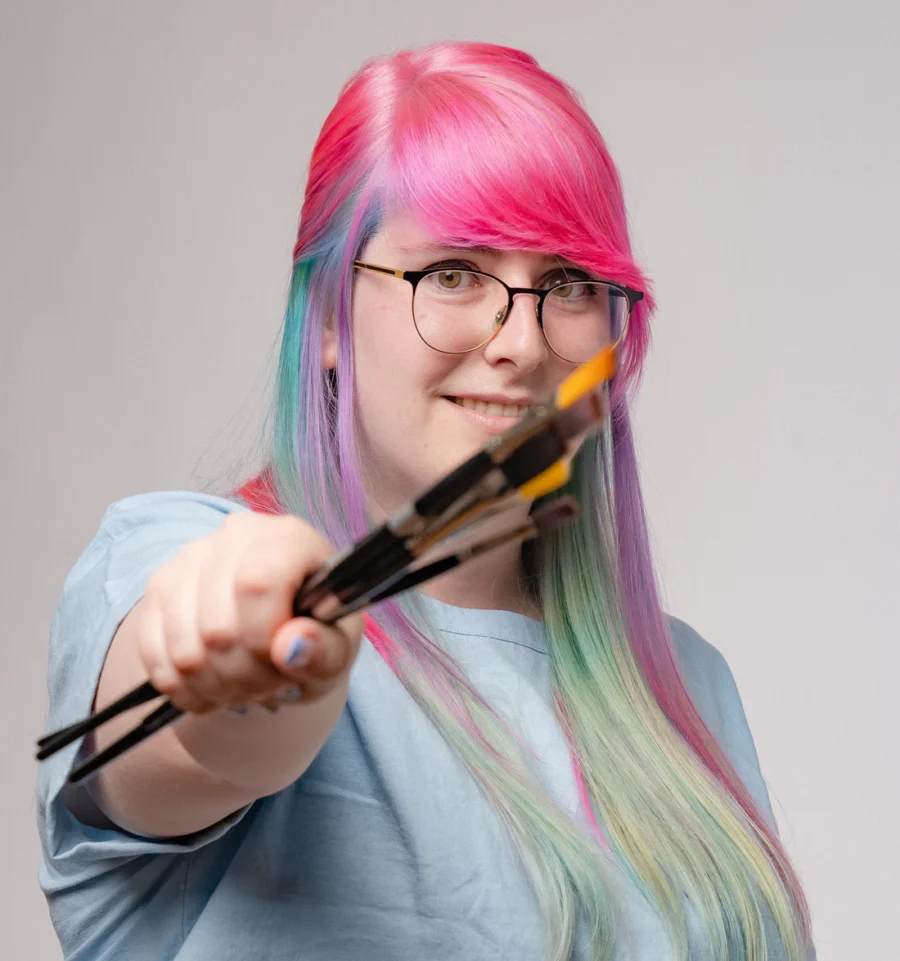In an era increasingly shaped by digital media, painting continues to hold a powerful relevance, with artists like Alia Ganuza giving the traditional still life a new life in the hyper-connected world. Her canvases are noted for their vibrant, hyperreal energy, transforming the mundane details of daily life into captivating works of art. Ganuza’s rise to prominence illustrates a significant shift in the contemporary art world, where traditional techniques are intersecting with the vast reach of digital platforms. Her journey challenges traditional routes to success, positioning her as a key figure in understanding the evolving relationship between artists, their audiences, and the market.
Ganuza actively uses platforms like Instagram and TikTok, where her process videos have garnered millions of views. This direct engagement with a global audience demystifies the act of painting and builds a connection that is uncommon in the traditional art world. Her “hyper-vivid” style is particularly well-suited for online platforms, which prioritize immediate visual impact and shareability. This digital-first approach has allowed the still life genre to broaden its cultural footprint, moving from a subject of quiet contemplation to one of immediate visual engagement. Ganuza’s success on social media also demonstrates how these platforms are decentralizing art discovery, enabling artists to bypass traditional intermediaries and build direct relationships with their audience. This has made art more inclusive and accessible to a wider global audience.
From Equations to Easel: Ganuza’s Artistic Genesis
Alia Ganuza’s journey to becoming a celebrated artist is both unconventional and inspiring. Born in Bilbao in 1993, she initially pursued a degree in Physics, driven by practical concerns and the belief that an art career was not financially stable. This scientific background, particularly her fascination with optics, would later be a foundational influence on her understanding of light and color in her artwork. At age 22, after a personal low point, she decided to follow her passion and enrolled in Fine Arts at the University of the Basque Country.
Early in her career, Ganuza focused on photorealistic commissioned portraits. However, this work was ultimately unfulfilling due to client demands for realism over expressive brushwork and vibrant colors. The 2020 pandemic marked a turning point, providing a “crucible for her creativity”. During this time of introspection, she began a daily painting practice for herself, sharing her work on social media. This period of self-study allowed her to overcome inhibitions and find her authentic artistic voice.
Influenced by other artists on social media, such as @not_sorry_art, Ganuza adopted a “fast, spontaneous approach to painting”. Her signature style is characterized by vibrant oil paintings with expressive brushwork and an innovative use of the medium. She frequently uses the “alla prima” (wet-on-wet) technique, which allows for immediacy and visible brushstrokes. Her scientific background is evident in her use of colorful imprimaturas, or underpaintings, in hues like pink, teal, or yellow. This deliberate choice, rooted in her understanding of color theory and optics, helps her achieve more saturated colors and create “nice happy accidents”. Her thematic focus on transforming “mundane” and “everyday scenes” like frying eggs or dirty dishes into captivating works resonates with a wide audience and challenges the idea that art must always depict grandiose subjects. Her background in physics is not just a biographical detail; it informs a methodological and philosophical approach to her art, enabling her to systematically manipulate light and color.
The Canvas and the Algorithm: Ganuza’s Contemporary Footprint
Alia Ganuza’s artwork is instantly recognizable for its luminous quality, which she achieves using oil paints with expressive, spontaneous brushwork. She often uses the alla prima technique and incorporates colorful underpaintings to create saturated hues. Her focus on elevating mundane, everyday subjects, from dirty dishes to food-inspired still lifes, transforms common objects into captivating studies of light and color, allowing viewers to find wonder in the familiar. This approach aligns with contemporary still life trends that reimagine everyday objects, often with a focus on personal narratives or consumerism.
Ganuza’s art has quickly gained market traction. Her original paintings are available through established galleries like Abend Gallery and platforms like Artsper. She has also participated in major art fairs, such as the LA Art Show in 2025, and has been featured in local news. Her online storefronts, including her personal website and Etsy, enable a direct-to-consumer model that supplements her gallery presence. This hybrid strategy allows her to connect with both traditional collectors and a broader online audience.
The success of her work is closely tied to her strategic use of social media. By consistently sharing her daily painting practice online starting in 2020, she rapidly built a global following. Social media platforms like Instagram, YouTube, and Patreon have been crucial to her success, allowing her to bypass traditional gatekeepers and directly connect with her audience. This allows her to showcase her creative process and foster personal connections that drive sales.
In addition to selling art, Ganuza has built a thriving creative community. She shares her process through educational content, including YouTube tutorials, Domestika courses, and in-person workshops. Her Patreon community provides exclusive content and further supports her work. By promoting the belief that anyone can become an artist with passion and dedication, she has become an educator and community leader. This multi-faceted approach aligns with the “influencer” model in the creative economy, diversifying her revenue streams and building a loyal following beyond just art buyers. This suggests a fundamental shift in the artist’s career path, where artists are increasingly becoming adept at self-promotion, content creation, and direct audience engagement, functioning as micro-businesses.
The Critical Lens: Navigating Authenticity and Influence
A notable aspect of Ganuza’s career is the contrast between her significant online popularity and commercial success and the limited presence of in-depth critical reviews from major art publications. While she has received local media coverage and features in lifestyle publications, extensive critical analysis in prominent art journals is less apparent. This raises questions about how social media is reshaping artistic validation. These platforms often favor immediate visual appeal and “shareability” over nuanced critical discourse, which can reduce art to easily consumable content. Critics have suggested that this digital viewing experience can strip art of its “depth and complexity” by losing critical elements like scale, texture, and physical presence.
The commercialization of art on social media also presents challenges, including issues of intellectual property and the pressure for artists to create content that is likely to go viral rather than taking creative risks. The ease of direct sales bypasses the traditional gallery vetting process, which historically served as a form of quality control. While social media democratizes access to art, it can also create a “hyper-saturated environment” where it is difficult for emerging artists to stand out.
Ganuza’s success suggests a parallel system of validation, an “algorithmic canon” where prominence is determined by virality, engagement metrics, and direct sales rather than established critical frameworks. This challenges the traditional authority of critics and institutions in defining artistic merit and significance. Furthermore, while her transparent sharing of her creative process fosters a genuine connection, the need to constantly produce content for algorithms can turn the artistic process into a performance. This can blur the line between genuine artistic exploration and strategic self-branding designed for virality, raising ethical questions about artistic integrity in the age of digital self-promotion.
Ganuza’s journey demonstrates that the “myth that ‘art doesn’t pay the bills'” is not true, and that the direct-to-consumer models facilitated by social media offer viable economic pathways for artists. This shifts financial power from traditional intermediaries to the artists themselves, and has significant implications for aspiring artists and art education.
Beyond the Pixel: The Future Trajectory of Vibrant Realism
The contemporary painting landscape is characterized by a dynamic evolution, embracing both traditional mastery and technological integration. The still life genre, Ganuza’s primary focus, is experiencing a renaissance, with artists reimagining it through new perspectives, often incorporating elements of pop culture. Ganuza’s hybrid practice, which blends traditional oil painting with a strong digital presence, positions her at the forefront of this evolution. Her use of digital tools like the iPad for mock-ups suggests a comfort with technology that she may further explore in the future, possibly through augmented reality or generative art. Her educational initiatives on platforms like Domestika also suggest a continued role in democratizing art education and fostering a global community.
The trajectory of social media-native artists like Ganuza indicates a potential divergence between the online art market and traditional institutional validation. Artists succeeding online may create their own parallel “art world” with independent curators and direct patronage models, further decentralizing the art market. However, there is also the possibility that the traditional art world will increasingly acquire works by social media-native artists and engage more critically with their work in an effort to remain relevant. The success of artists who master both artistic quality and digital engagement could lead to a re-evaluation of traditional gatekeeping mechanisms.
The art market is already adapting, with online art sales accounting for a record share of the global market. The demand for “one-of-a-kind art” with “human elements” alongside digital proliferation suggests a continued appreciation for traditional mediums. Ganuza’s “phygital” approach, which combines traditional oil painting with digital tools and social media, represents a sustainable model for future artists. This indicates that the future of painting is not a binary choice between traditional and digital, but a synergistic integration of both. Artists who can navigate both realms will be best positioned for long-term success. Ganuza’s role in creating, teaching, and selling art directly empowers her to control her narrative, distribution, and revenue streams, lessening her reliance on traditional gatekeepers. This points to a democratization of the art market, where artists are becoming more entrepreneurial and building sustainable careers through diverse income streams.
Finally, the fact that Ganuza’s works are sold through both galleries and online platforms, with social media acting as a primary channel for discovery and purchase, shows a growing comfort among collectors with acquiring physical art through digital means. This expands the global art market and lowers barriers for new collectors.
In conclusion, Alia Ganuza’s career serves as a compelling case study for the contemporary art world. Her success underscores that artistic merit and market viability are being redefined outside traditional institutional confines, driven by authenticity and accessibility. Her holistic approach of creating, teaching, and direct selling points to a future where art entrepreneurship is a core competency for successful artists. This shift empowers artists with greater autonomy and financial independence, suggesting a more democratic art market in the future. The relative lack of critical reviews from traditional publications highlights their evolving role from primary gatekeepers to vital interpreters who provide deeper analysis and context that social media platforms often cannot offer.









